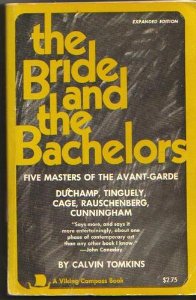
I made my visit to Terrace Books a few weeks ago, and found it to be the kind of Platonic ideal of a used bookstore: cleanly laid out, well-stocked, and a generally pleasant place to browse. (See also: Human Relations; Book Thug Nation.) While there, I picked up a collection of linked essays by Jeanette Winterson, titled Art Objects. It begins with Winterson musing on how she essentially educated herself in terms of appreciating art; as someone who similarly doesn’t have much of a formal background in art history, this resonated with me more than a little. As one progresses through the book, one finds musings on Woolf and Dickens, thoughts on collecting first editions, and Winterson reflecting on her own work. (Or, rather, her work up until that point — this collection was originally released in 1997.) It’s an insightful look, both at Winterson’s own creative process and the shaping of her aesthetic.
From there, I proceeded to another collection of musings on art, this one from Calvin Tomkins. The Bride and the Bachelors dates from the late 1960s, and focuses on a quartet of artists whose work helped to define a particular section of the avant-garde. Profiled here are John Cage, Merce Cunningham, Jean Tinguely, Robert Rauschenberg, and Marcel Duchamp. Each of these pieces provides a solid overview of their subject’s life, work, and artistic development. I think I may have been spoiled by reading Tomkins’s The Lives of the Artists first, as his more recent work has delved more deeply into his subjects’ relationships and economic background without ever feeling intrusive. These feel a bit more removed — although I assume some of that stems from the time in which these essays were written. And for a good overview of five essential artists, this is hard to beat.
And from art widely beloved to music widely disparaged. Nathan Rabin’s You Don’t Know Me But You Don’t Like Me is a book about Rabin looking at two particular musical subcultures: Phish fans and Juggalos. Rabin’s aim here is to humanize two groups which are largely dismissed. For the latter, readers who’ve read coverage of the group by the likes of Camille Dodero or Christopher Weingarten (the latter of whom shows up here), some of this won’t be news, but the intensity of Rabin’s argument is effective regardless of how much of a reader of Insane Clown Posse-related discourse you are. This ends up overshadowing the Phish sections a bit (though I will say that Rabin’s discussions of certain songs made me curious about hearing Phish for the first time since 1996 or so.) The book is also as much about Rabin’s mental state as he wrestles with his subject, subjects himself to occasionally grueling transit experiences, and occasionally has sketchy experiences at a Motel 6. There’s charm and cringeworthy moments in equal measure to be found here.
Follow Vol. 1 Brooklyn on Twitter, Facebook, Google +, our Tumblr, and sign up for our mailing list.

1 comment
quintet!